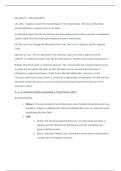McCulloch v. Maryland(1819)
(A) 1816, Congress created The Second Bank of The United States. The State of Maryland
passed legislation to impose taxes on the bank.
(I) Maryland argued that the second bank was unconstitutional because no specific constitutional
outline would allow the federal government to create a federal bank.
(R) The case went through the Maryland State Court, the Court of Appeals, and the Supreme
Court.
Question of Law: The two questions of the Supreme Court were: Did Congress have the
authority to establish the bank? And, did the Maryland law interfere with congressional powers?
Ruling: McCulloch made a unanimous decision. The court decided that Congress had the power
to create and incorporate the bank, and the Maryland tax was unconstitutional because it
infringed on congressional power. Chief Justice Marshall defined the ‘necessary’ in the
Necessary and Proper clause (article 1, section 8) as appropriate and legitimate. He also said that
Maryland retained the power to tax but could not tax the federal government because of the
supremacy clause.
A. L. A. Schechter Poultry Corporation v. United States (1935)
BACKGROUND:
1. History: This was during the Great Depression when Franklin Delano Roosevelt was
president. Congress established the National Industrial Recovery Act under this when
establishing the New Deal.
2. AIR:
1. Action: The National Industrial Recovery Act allowed the president to
regulate specific industries by distributing authority among business
groups and their boards.
2. Injury: Schechter Poultry Corp. claimed this power given to the president
violated the non-delegation doctrine.
, 3. Route: The Schechter Poultry Corporation was convicted by the district
court of violating numerous standards the National Recovery
Administration set. After an appellate court reaffirmed this ruling, the
case was taken to the Supreme Court.
THE QUESTION OF LAW:
“Did Congress unconstitutionally delegate legislative power to the President by allowing
him to regulate certain industries without providing guiding standards?”
ANALYSIS OF THE COURT’S LEGAL REASONING:
The court’s vote was unanimous, stating that The National Industrial Recovery Act
unconstitutionally delegated powers of the legislative branch to the president. Chief Justice
Hughes delivered the concurring opinion of the court, which deemed Section 3 of the Recovery
Act unconstitutional and without precedent. He claimed that this did not provide any regulations,
just codes for the president to “prescribe” rules so he could enact laws. Justice Cardozo, joined
by Justice Stone, also delivered a concurring opinion ruling that if “fair” competition codes are
implemented to eliminate the “unfair” codes of competition, then the legislative delegations
made by Congress to the president will not be deemed unlawful. He thought this because, if
needed, it would promote the nation's well-being.
PRECEDENTS & AUTHORITIES:
1. Panama Refining Company v. Ryan (1935): This case ruled that The National
Industrial Recovery Act unconstitutionally delegated legislative powers to the
president
2. The Constitution: Article 1, Sections 1 and 8: The first section of Article 1 talks
about how all legislative powers are vested only in Congress. Furthermore, the eighth
section of Article 1 talks about how Congress can make all laws that will be
necessary for carrying into execution.
Hammer v. Dagenhart 247 U.S. 251 (1918)
, Action: Congress passed the Keating-Owen Child Labor Act in 1916, which regulated child
labor through the regulation of interstate commerce. It made it so that no goods produced in part
by child labor could be part of interstate sales.
Injury: Roland Dagenhart, the father of Reuben Dagenhart, claimed that his freedoms were
being violated because he could not allow 14-year-old Reuben Dagenhart to work in a textile
mill.
Route: Dagenhart successfully took his case to the United States District Court. Hammer
appealed, and the case was brought to the Supreme Court.
Question of Law:
Does the Keating-Owen Child Labor Act of 1916 violate the Commerce Clause?
Does the Keating-Owen Child Labor Act 1916 violate the States’ 10th Amendment rights?
Decision: The Supreme Court ruled 5-4 in favor of Dagenhart, claiming that the Keating-Owen
Child Labor Act did not fall under the Commerce Clause and, therefore, could not be enforced
by Congress. The Supreme Court also stated that the regulation of production was a power
reserved to the States through the 10th Amendment. Justices Day, White, Van Devanter, Pitney,
and McReynolds ruled for Dagenhart, while Justices McKenna, Holmes, Brandeis, and Clarke
dissented. Justice Day wrote the court's opinion, and Justice Holmes wrote the only dissenting
opinion.
Analysis of Legal Reasoning: The Supreme Court’s reasoning rests on two main principles: the
Commerce Clause and the 10th Amendment. Justice Day argues that Congress’s use of the
Commerce Clause to pass the Keating-Owen Child Labor Act is unconstitutional and is a far
reach for the Commerce powers. The Court believes that the production of goods is not
commerce and cannot be regulated by Congress with the powers of the Commerce Clause. If
Congress was not given the power to regulate production through the Constitution, then it is up
to the States to regulate it as they please through the 10th Amendment. Justice Day defines
commerce as the intercourse, traffic, and transportation of persons and property and the buying,
selling, and exchanging of goods. With this definition, he strikes down Congress’s ability to
regulate production.




